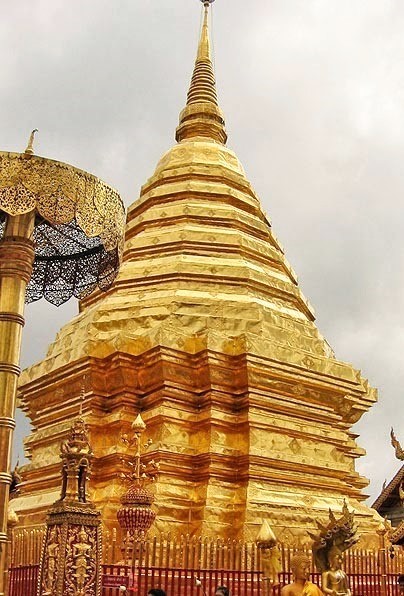
Wherever you are in Chiang Mai city you can’t help notice the imposing mountain to the west. Look more closely and you’ll spot the temple perched on the mountainside. This is Wat Phra That Doi Suthep; Chiang Mai’s most important temple. The summit behind it is Doi Pui – Thailand’s eighth highest mountain at 1,685m. Since the founding days of Chiang Mai, Doi Suthep temple has acted as a spiritual guardian to the city and it remains one of Thailand’s most visited temples.
On a clear day you can easily see the shimmering gold of the temple’s chedi. It was built in the 14th century and the rest of the temple complex has been added over the centuries. According to legend, a relic of the Buddha was placed on the back of an elephant that trundled up the mountain and came to a halt at the place where the temple now stands, making it symbolically auspicious. Before a road was built up the mountain by famed monk Khru Ba Srivichai in the 1930s, people walked up to the 1,050-metre high summit to make their merit. Today, it is a 20-minute ride and Thais come from all over the country to visit this particularly important temple.
The meandering journey up the mountain is lovely, winding through lush rainforest and passing several waterfalls. It’s an easy afternoon trip on a rented motorbike. Tours are also widely available and include a visit to other sites of interest on the mountain. Half way up is an excellent view courtesy of a lookout platform.
There are also several wonderful waterfalls; most notably Huay Kaew Waterfall near the base where you’ll notice the Thai visitors stopping off to pay their respects to the statue of Khru Ba Srivichai. A third of the way up is a more impressive waterfall, Monthatan Waterfall, and nature area.
The temple sits on a distinctive peak and supports a community that sells souvenirs and runs restaurants. Entry to the temple is via an exhausting 300-step stairway lined with two elongated nagas (protective serpents), or you could cheat and take the funicular.
The centrepiece of Wat Doi Suthep is the magnificent gilded chedi and its peaceful courtyard. Take note that you should dress respectfully when entering the temple, which means no skirts, shorts, and vest tops. Fisherman’s pants can be hired for a minimal fee.
Here, you will notice plenty of Thais making merit: walking clockwise around the chedi three times, clasping a lotus bud and incense. This temple is considered one of the most important in all of Thailand and there are also a number of religious antiques and symbolic icons on display. A humbling view of Chiang Mai valley is the other main highlight, and there is also a meditation centre onsite.
The Doi Suthep – Pui National Park, which encompasses the entire area, has other attractions as well. A 20-minute ride farther up the mountain will take you to the Phuping Winter Palace, which is a popular residence for the current royal family. Although entry to the palace is restricted, you can admire the lovely gardens.
Not far beyond the palace, if you bear left at the t-junction, you descend sharply into a Hmong village nestled in an isolated valley. While this is a commercialised version of a hill-tribe settlement, it nonetheless is an accessible glimpse into such a community and boasts its own waterfall decorated with nice gardens.
If you backtrack up the hill to the t-junction and then head in the opposite direction, you will climb steadily through a wonderful wooded environment and chance upon a great lookout point with a sweeping view of the mountains, with a hill-tribe village immediately below you. Continue on the road and you will eventually reach the national park check point, with a restricted access path to the summit.
From the check point, the road descends sharply to a campsite, forest station (with simple coffee shops and huts for hire), and a more authentic hill-tribe village, Baan Chiang Khian, before winding its way down through some incredible scenery. The road is now sealed as far as the coffee shop but, thereafter, it’s strictly for 4X4s with experienced drivers or mountain bikers. The road eventually exits at the Huay Tung Tao reservoir beside the base of the mountain, from where you can find your way back to the city. This lake is surrounded by floating restaurants and is a good recreation area.
There are also plenty of roadside spots to stop and go walking into the wonderful rainforest that becomes increasingly lush as you climb the mountain.
The easiest way to visit the temple is to rent a motorbike and ride up – the switchback road is safe and in good condition and it only takes around 20 minutes from Chiang Mai Zoo (at the foot of the mountain). This option also gives you the freedom to stop at viewpoints and waterfalls, though if you’re not confident with bikes then consider renting a car or chartering a taxi, minibus or songthaew. The latter is the cheapest option and they wait outside the zoo for tourists. To get to this point from the city, other songthaews make the run throughout the day. Tours to Doi Suthep are also offered by agents in Chiang Mai.
Further reading…
- Doi Inthanon National Park
- The Mae Hong Son Loop Route
- Koh Chang Beaches Guide
- Koh Tao Transportation

